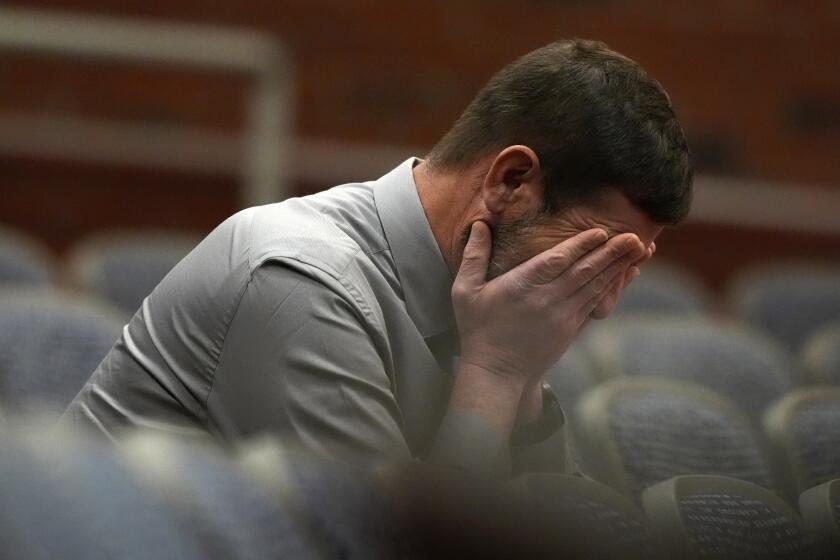First Post-Challenger Shuttle Flight Delayed : NASA Cites Failure of Key Motor Component in Test Last Week of Redesigned Booster Rocket
In a blow to NASA, the first scheduled launch of the space shuttle since the Challenger disaster has been delayed indefinitely because of a flaw discovered in a test of the spaceship’s redesigned solid-fuel rocket booster, space agency officials announced Tuesday.
Although the delay in the scheduled June 2 launch could be as little as a few weeks, National Aeronautics and Space Administration scientists do not know why a key component in the booster failed and “any estimate of when we can launch will be refined as time goes on,” spokesman Dwayne Brown said.
Beset by Delays
The latest setback to the shuttle program--which has been beset by delays--was discovered after a test last Wednesday of the booster rocket at the facilities of Morton Thiokol Inc. in Utah, where it is manufactured. On Tuesday, in an unrelated incident, a fire at the site killed five employees and destroyed an MX missile facility.
At first, NASA officials said the shuttle’s massive, 126-foot booster rocket had performed properly during the test firing last week. But they later discovered that part of the rocket’s nozzle had come apart during the test.
Engineers reported that material was missing from the nozzle’s “outer boot ring,” which had been redesigned by Morton Thiokol, according to a statement released by the space agency.
The nozzles are crucial because they are used to steer the shuttle during the first two minutes of flight, said John Thomas, a NASA engineer who heads the solid rocket booster redesign team.
Although NASA officials do not believe that a failure of such equipment during a shuttle flight could lead to a Challenger-type disaster, the problem is “certainly one we have to look into. . . . We’ve never fully evaluated that (nozzle) failure mode,” Thomas added.
Moreover, “it is conceivable” that a breakdown in such components could pose a serious threat to the shuttle, depending on when they took place during a flight, said Thomas, who works at the Marshall Space Flight Center in Huntsville, Ala.
“We’ve got to understand precisely what happened, what time during the firing that it happened and then assess the situation,” he added. “Subjectively, some (NASA scientists) think there might be” a major threat posed to the shuttle by such a failure. “It’s a subjective condition at this point.”
Rocket Inspection
As a result of these concerns, the full extent of the launch delay “will not be known for the next several days,” according to the NASA statement. Full results of the test firing will not be known until the 1.2-million-pound rocket is disassembled for inspection.
Last Wednesday’s test was the second in a series of four test firings of the redesigned rocket motor that had been ordered by NASA officials before the scheduled June 2 launch. That flight, by the shuttle Discovery, had been expected to carry a crew of five headed by astronaut Frederick H. Hauck.
If the Discovery flight proves successful, NASA plans to resume a heavy launch schedule. Agency officials said in October, for example, that they were planning 19 shuttle flights over the next three years.
Despite the latest setback, NASA officials stressed that the rocket’s redesigned field joint--which failed during the Challenger disaster--performed well during the test last week.
“There is no relationship between that case and the results of this particular test,” NASA spokeswoman Sarah Keegan said. Still, she added, the discovery of a new shuttle problem means that “we’re certainly not going to shift this hardware down to the Cape (Kennedy Space Center) and put it together until we understand it better.”
The failure of several “O-rings” attributed to leaky seals in the shuttle’s field joints caused the destruction of the Challenger on Jan. 28, 1986, and the deaths of its seven-member crew 72 seconds after launch. Since then, the three remaining shuttles have been grounded while NASA and Morton-Thiokol worked on a $460-million redesign of the rocket booster.
NASA officials began testing the redesigned booster in August and reported that the new equipment was performing properly, based on preliminary findings.
More to Read
Start your day right
Sign up for Essential California for news, features and recommendations from the L.A. Times and beyond in your inbox six days a week.
You may occasionally receive promotional content from the Los Angeles Times.






